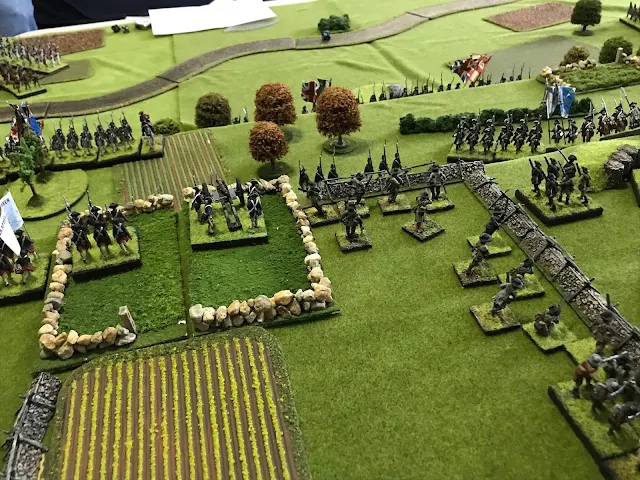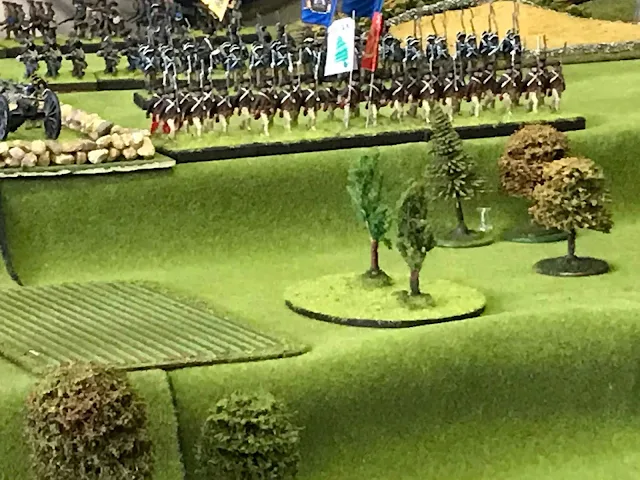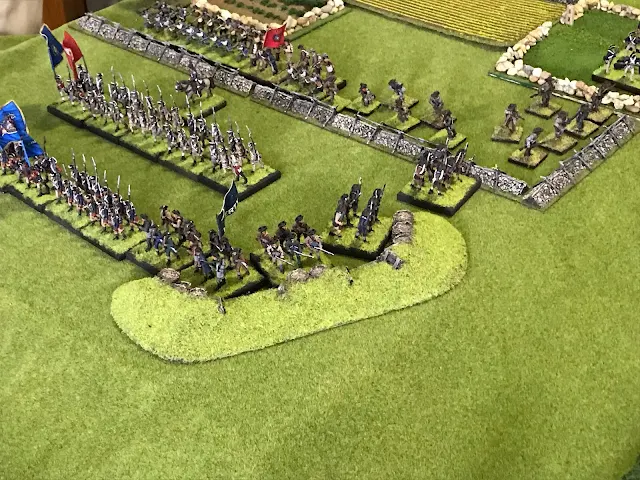At the end of October 1776 Washington had retreated from Manhattan to Winchester county New York. Taking position at the village of White Plains the Americans dug fortifications. But they left a low series of hills and ridges to their right empty and unoccupied. On the morning of 28 October both sides raced to capture these ridges. The Americans arrived first and started a small entrenchment. The advancing British crossed the Bronx river to attack the Americans while a Hessian Brigade out flanked the position. After causing heavy British casualties the Americans retired off the field.
Because of the interesting troop types and colorful nature of the time of year I thought this would be a wonderful table top battle. In addition the battle holds a warm memory for me as the very first battle reenactment I took part in in October 1972. American Heritage magazine ( in April 1973, volume 24, issue number 3) has a picture of my young self in ranks of my first regiment! Janine volunteered to make lunch for the group of us. A wonderful spaghetti and sausages with salad feast. So now on to the game!
American forces consisted of a brigade of four militia battalions from Connecticut and Massachusetts. General McDougall 's Continental brigade (19th Continental, 1st and 3rd New York Regiments and Smallwood's Marylanders). In addition Haslet's Delaware regiment and Captain Alexander Hamilton's artillery battery arrived to assist. The Americans were to hold the hill as long as possible and cause as many British casualties as possible. The Americans set up using the various walls and fences as cover.
view from the British position towards the American lines.
The British launched a brigade of four battalions across the Bronx river to assault the American position. They were screened by two companies of the loyalist New York Volunteers.
Colonel Rall's brigade outflanks the American position. Here two foxes watch as regiments Knyphausen, Lossburg and Rall advance up the hill. A detachment of Jagers skirmishes ahead of them.
Between the British brigade and Rall the von Bose and 17th Light dragoons advance.
The British command set up on Wolf hill opposite Chatterton hill. A battery of three heavy guns were set up. Although they could not move from that position they did provide support. A battalion of Light Infantry and Grenadiers stood guard as reserves. Lastly Sir William Howe observed the attack (distracted by Mrs Loring). A Shepard and his flock seen unimpressed by the unfolding battle.
The American brigadier moves his battalions up to the crest of the hill. Curiously instead of advancing the rifle armed skirmishers they are kept behind the main line defense.
The American center is held by two Continental regiments and two militia regiments, Hamilton,'s battery and some riflemen.
Taking advantage of the stone walls he positions his battalions. Hamilton's battery takes a position to pound the advancing British in a enclosed field. Lastly, the 19th Continental battalion advanced down hill to annoy the British.
The American left flank is guarded by a small redoubt manned by a militia regiment. A New York continental regiment supported by Smallwood's Maryland Regiment and a militia battalion protect the exposed flank.
The New Yorkers take heavy fire from the three Hessian battalions. They fail their morale test and rout. Smallwood's stands alone against the advancing Germans.
Suffering heavy casualties the Grenadier Regiment Rall fails its morale test and routed back down the hill. The remainder of the brigade continues its advance. The jagers skirmish against the militia in the redoubt. Note the 17th Light Dragoons have flanked the American line!
All of this is too much for the American commanders. The various militia battalions reacting to The routing or retreating units fail their morale and retreat. Wanting to save his Continental battalions he orders a retreat. This ended the game.
All agreed it was a fun scenario and they would like to play it again. I think next time the Americans could be more agressive. Playing it again they could have advanced the rifle armed men to snipe and skirmish with the advancing enemy. This will make the British advance more difficult. I also wonder if the Royal Artillery battery in the hill was too powerful. I might take away one stand of guns in my next try. I will add a few more walls and fences next time and add some fall color trees to get the time of year correct. All in all a successful game that will be fought out again. Thank you to Andy, Jim, Warren and George for attending and playing.






















































